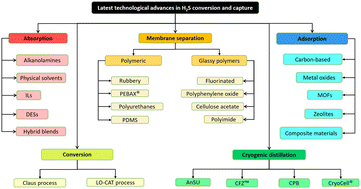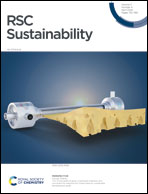Latest technological advances and insights into capture and removal of hydrogen sulfide: a critical review
Abstract
Hydrogen sulfide is an extremely toxic, poisonous and flammable gas often found in natural gas streams and crude oil reservoirs. Due to its hazardous and corrosive nature, it must be effectively removed to protect human health and for economic reasons. To overcome these issues, various technologies and methods have been implemented for efficient capture of H2S. This work presents a comprehensive review of various up-to-date technologies and materials such as ionic liquids, deep eutectic solvents, carbon-based adsorbents, zeolites, metal organic frameworks, membranes and composite materials. Furthermore, an in-depth discussion for each technology and class of material is also included. Besides, potential opportunities and limitations are also identified to further enhance the development in future research. By evaluating eco-friendly and cost-effective techniques, our work contributes to reducing harmful emission of H2S, protecting air quality and promoting cleaner industries. Our work aligns with the UN's sustainable development goals, specifically SDG 7 (affordable and clean energy) and SDG 13 (climate action), by advocating for a cleaner and more sustainable energy sector, as well as SDG 9 (industry, innovation, and infrastructure) through innovative solutions for cleaner industrial processes.

- This article is part of the themed collection: RSC Sustainability Recent Review Articles


 Please wait while we load your content...
Please wait while we load your content...